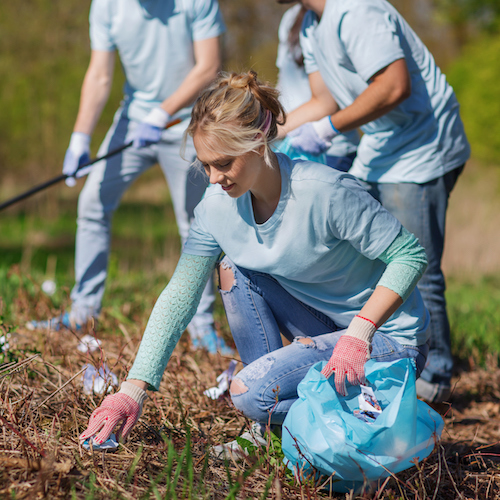
Some 62.6 million Americans volunteered a total of 7.8 billion hours in 2015. The total dollar value of volunteer time nationwide has been estimated at nearly $184 billion.
While nationally, about one in every four adults volunteers annually, in some parts of the country, volunteering is much more common. 24/7 Wall St. reviewed data from the Corporation for National and Community Service to identify the states with the highest rates of volunteerism. In Louisiana, just 18.4% of residents 16 and older volunteer each year, the lowest share of any state. In Utah, a nation-leading 43.3% of adults volunteer each year.
[in-text-ad]
Volunteer work is typically done through an organization or group. In the vast majority of states, religious groups and churches are the primary drivers of volunteerism. The second most common type of organizations that Americans volunteer through are educational and youth service programs.
Click here to see the states volunteering the most.
Beyond involvement in faith-based groups and educational programs, a variety of socioeconomic conditions influence volunteer rates in a given state. In an interview with 24/7 Wall St., Mary Love, spokesperson for the CNCS, explained that “some aspects of an area can make it easier or harder to get people involved.”
Two of the strongest correlations with volunteerism is the share of adults with at least a high school diploma and the share of residents in a given area living in poverty. “These socioeconomic factors [affect] the time available to volunteer, as well as… the amount of opportunities available for them to become involved,” Love said. To be sure, at least 90% of adults have a high school diploma in every state with the highest volunteer rates, while nationwide, 87.1% of adults have graduated high school. Additionally, Idaho and Oregon are the only state on this list with a higher poverty rate than that of nation.
Perhaps the strongest and most intuitive correlation with volunteer rates is homeownership. According to Love, “Greater attachment to a community encourages volunteering and owning a home tends to signify a personal interest to the long-term success of a community.” Only three of the states with the highest volunteer rates have a lower homeownership rate than the national 63% figure.
Other important factors include commute times and the presence of nonprofit organizations. The average American commuter spends 26.4 minutes travelling to work. Love explained that “those with a long commute may have limited time available for volunteering…” The mean commute time is lower than the national average in 14 of the 15 states with the highest volunteer rates.
The presence of nonprofit organizations also play a major role in volunteerism in the U.S. “In order for people to volunteer, there needs to be capacity to recruit, place, and manage these volunteers – simply put, there must be infrastructure in place to support individuals wanting to volunteer,” Love said. It may also be the case that a greater presence of nonprofits in these states fosters interest in volunteerism among residents. Utah is the only state on this list with a less dense concentration of nonprofits than the nation as a whole.
To identify the states with the highest volunteer rates, 24/7 Wall St. reviewed the annual average percentage of state residents 16 and older who volunteered with an organization each year between 2013 and 2015 from the Corporation for National and Community Service. The survey also included state data on historical volunteer rates, where individuals volunteered primarily, and the types of volunteering activities. We also looked at state educational attainment rates, poverty rates, homeownership rates, commute times and median household incomes from the U.S. Census Bureau’s 2015 American Community Survey. The number of nonprofit organizations per 10,000 state residents came from the National Center for Charitable Statistics. The value of volunteer hours by state was calculated by Independent Sector, a charitable sector advocacy group. Annual unemployment rates are for December 2016 and came from the U.S. Bureau of Labor Statistics.
These are the states volunteering the most.

15. Washington
> Volunteer rate: 30.6%
> Adults with at least a high school diploma: 90.8% (16th highest)
> Total value of volunteer work in 2015: $6.14B (8th highest)
> Unemployment rate: 5.2% (tied – 10th highest)
Unlike most states, Washington residents are more likely to volunteer through an educational or youth service organization than through a church. Only about a quarter of state residents who volunteer do so through their church, while 28.4% are involved in youth services or education.
Low poverty rates and high educational attainment are common in areas with robust volunteerism. In Washington, only 12.2% of residents live in poverty and 90.8% have at least a high school diploma, compared to the 14.7% and 87.1% national rates.
[in-text-ad]

14. North Dakota
> Volunteer rate: 30.7%
> Adults with at least a high school diploma: 92.5% (5th highest)
> Total value of volunteer work in 2015: $429.2M (3rd lowest)
> Unemployment rate: 3.0% (tied – 6th lowest)
North Dakota is one of a minority states where more than 30% of the 16 and older population volunteers each year. As is the case in much of the rest of the country, churches and religious organizations are the most popular channels for volunteerism in the state, accounting for some 37.1% of all volunteer participation. Like many other states with high volunteer participation rates, North Dakota has a relatively dense concentration of nonprofit organizations. Statewide, there are nearly 80 nonprofits for every 10,000 residents, more than double the national concentration of 34 per 10,000 people.
Lower poverty levels are associated with higher volunteer participation rates. In North Dakota, only 11.0% of the population lives in poverty, well below the 14.7% national rate.

13. Oregon
> Volunteer rate: 31.4%
> Adults with at least a high school diploma: 90.0% (20th highest)
> Total value of volunteer work in 2015: $2.64B (24th highest)
> Unemployment rate: 4.6% (tied-25th highest)
A relatively high density of nonprofit organizations can often be an indicator of a high volunteer participation rate. In Oregon, where 31.4% of the adult population volunteers each year, there are 55 nonprofits for every 10,000 residents, far greater than the comparable national figure of 34.
In a majority of states, religious organizations account for the highest share of volunteer participation. Oregon is one of the outliers. The largest share of volunteers in the state dedicate their time through educational or youth services. Oregon is one of only six states nationwide where fewer than a quarter of all volunteers are mobilized through a church or religious organization.
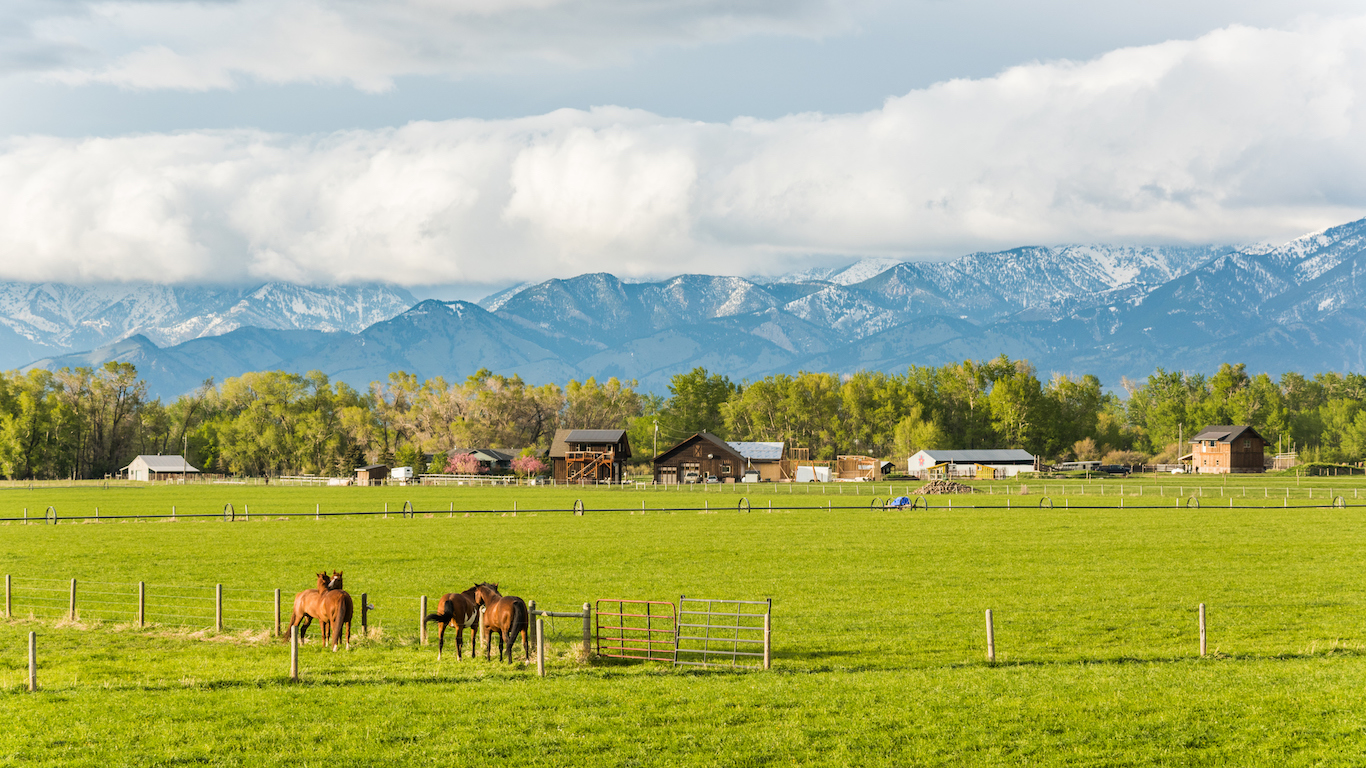
12. Montana
> Volunteer rate: 31.6%
> Adults with at least a high school diploma: 93.5% (the highest)
> Total value of volunteer work in 2015: $2.49B (24th lowest)
> Unemployment rate: 4.0% (tied – 17th lowest)
Nearly 32% of Montana residents age 16 and up volunteer each year, a larger share than in the majority of states. Nationwide, high educational attainment rates and a dense concentration of nonprofit organizations are associated with greater volunteer participation. In Montana, 93.5% of adults have at least a high school diploma, the largest percentage in the country. Additionally, there are 95 nonprofit organizations for every 10,000 residents, the highest concentration of any state.
As is the case in many states, people in Montana are more likely to volunteer through their church or religious organization than through any other group.
[in-text-ad-2]

11. Maine
> Volunteer rate: 31.6%
> Adults with at least a high school diploma: 91.7% (tied – 7th highest)
> Total value of volunteer work in 2015: $845.0M (9th lowest)
> Unemployment rate: 3.8% (12th lowest)
According to CNCS spokesperson Mary Love, homeowners are more likely to have a greater sense of attachment to their community, and an interest in its long-term prosperity. Consequently, areas with high homeownership rates also tend to have greater volunteer participation. Maine’s near nation-leading 71% homeownership rate likely drives up its volunteer participation. Each year, 31.6% of the state’s population volunteers, a larger percentage than in all but 10 other states.

10. Iowa
> Volunteer rate: 32.5%
> Adults with at least a high school diploma: 91.7% (tied – 7th highest)
> Total value of volunteer work in 2015: $1.85B (20th lowest)
> Unemployment rate: 3.6% (10th lowest)
An estimated 31.3% of Iowa residents age 16 and up volunteer each year, a larger share than in all but nine other states. Nonprofit organizations often rely heavily on volunteers and high volunteerism rates in Iowa are likely bolstered by a high concentration of nonprofit organizations. There are about 87 nonprofits in Iowa for every 10,000 state residents, the second largest share in the country and more than double the national figure of 34 per 10,000.
High homeownership rates typically mean a greater share of the population has a personal interest in their community’s long-term success. In Iowa, 70.7% of homes are owner occupied, a larger share than in all but half a dozen other states.
[in-text-ad]

9. Alaska
> Volunteer rate: 32.7%
> Adults with at least a high school diploma: 92.6% (4th highest)
> Total value of volunteer work in 2015: $552.2M (6th lowest)
> Unemployment rate: 6.7% (the highest)
Volunteerism rates tend to be higher in areas with relatively low commute times, as individuals with longer commutes may have limited free time to volunteer. In Alaska, the average commute time is only 19 minutes, one of the shortest of any state in the country.
In keeping with another national trend, the high volunteer participation rate in Alaska corresponds with a relatively high concentration of nonprofit organizations. Across the state, there are 66 nonprofits for every 10,000 residents, nearly double the national concentration of 34 organizations per 10,000.
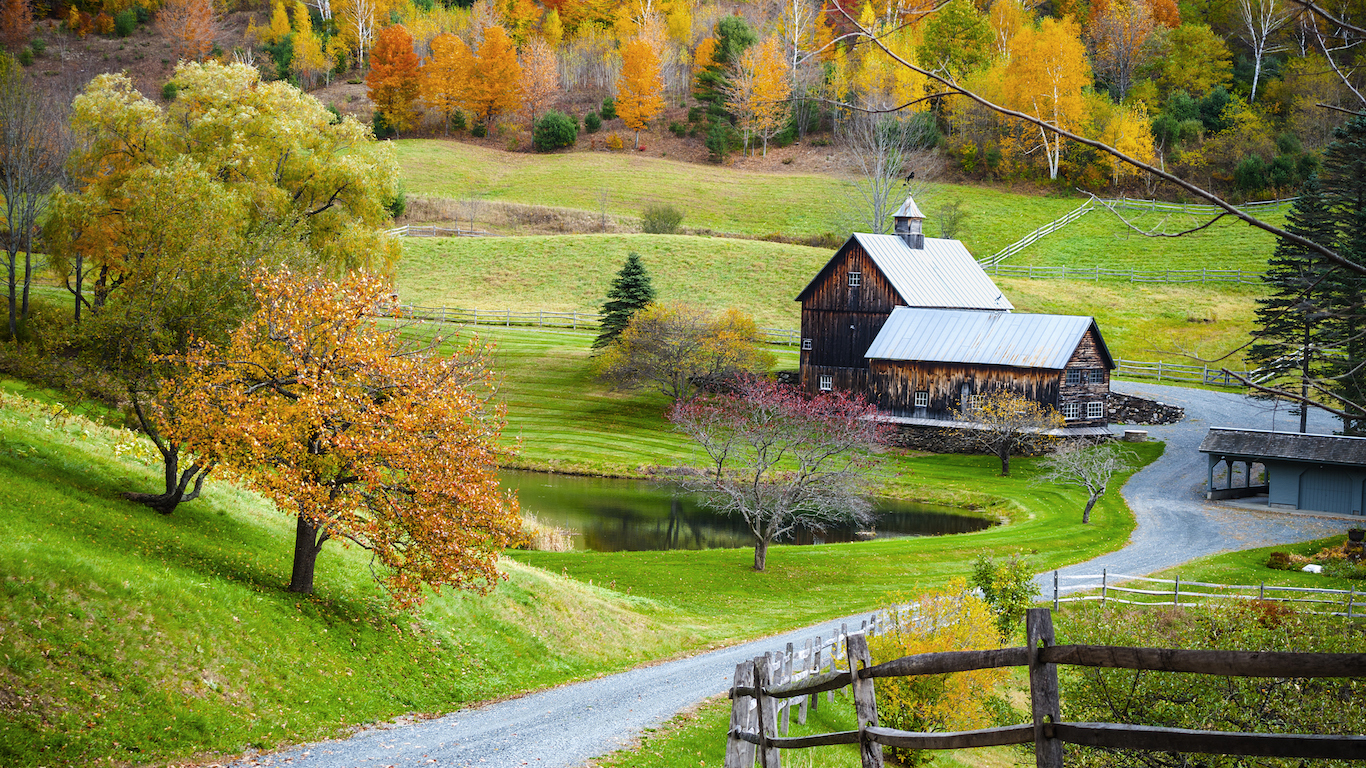
8. Vermont
> Volunteer rate: 33.1%
> Adults with at least a high school diploma: 91.7% (tied – 7th highest)
> Total value of volunteer work in 2015: $436.4M (4th lowest)
> Unemployment rate: 3.1% (tied – 8th lowest)
In most states, churches and religious groups account for the largest share of volunteer work. Vermont is a notable exception. Only 15.4% of volunteers in the state volunteer through a religious organization, the smallest share of any state. Some 28.3% of all state volunteers in work with educational or youth service groups, accounting for most volunteerism in the Green Mountain State.
Working adults are more likely to volunteer in their spare time than their unemployed counterparts. A high rate of volunteer participation in Vermont may be bolstered by a strong job market. Only 3.1% of the state’s labor force is out of a job, well below the 4.7% national rate.

7. Kansas
> Volunteer rate: 33.1%
> Adults with at least a high school diploma: 90.3% (17th highest)
> Total value of volunteer work in 2015: $1.70B (19th lowest)
> Unemployment rate: 4.2% (tied – 20th lowest)
Areas with strong high school attainment rates, high homeownership, and low poverty tend to also have greater volunteer participation rates. In Kansas, adults are more likely to own a home and have a high school diploma, and less likely to live in poverty than the typical American. These factors may partially explain why 33.1% of the state’s adult population volunteers annually, a greater share than the comparable 24.9% national rate.
According to estimates by Independent Sector, charitable sector advocacy group, the estimated value of all volunteer work in the country in 2015 was nearly $184 billion. Some $1.7 billion of this was generated in Kansas.
[in-text-ad-2]

6. Nebraska
> Volunteer rate: 33.7%
> Adults with at least a high school diploma: 91.0% (14th highest)
> Total value of volunteer work in 2015: $1.18B (17th lowest)
> Unemployment rate: 3.4% (9th lowest)
Nebraska is one of seven Midwestern states to have an especially high rate of volunteerism. There are several socioeconomic and environmental conditions in the state that contribute to this. People with longer commute times typically have less free time to volunteer; in Nebraska, the average commute is only about 18 minutes, nearly the shortest in the country. Additionally, homeowners tend to be more invested in their community and have a personal interest in their community’s long-term success; Nebraska residents are more likely to own their homes than the typical American.
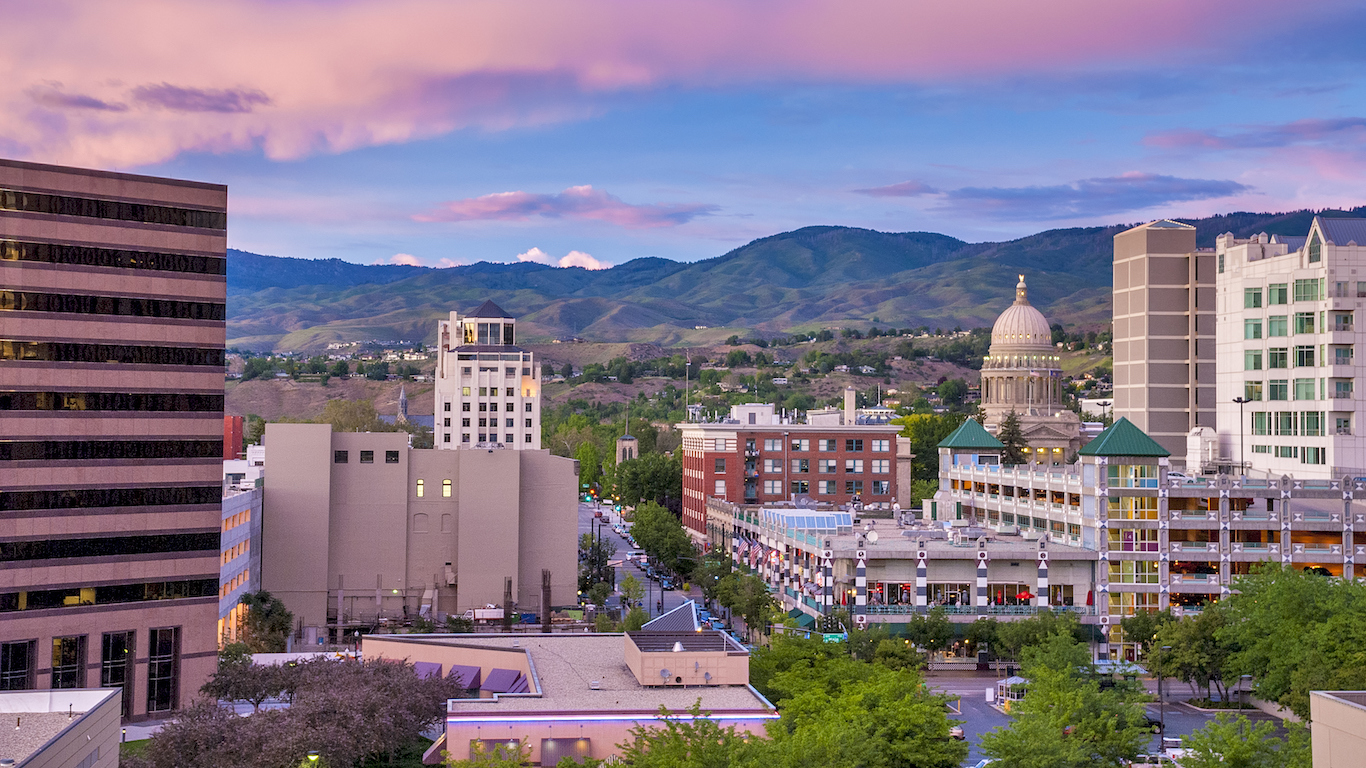
5. Idaho
> Volunteer rate: 34.1%
> Adults with at least a high school diploma: 90.0% (tied – 21st highest)
> Total value of volunteer work in 2015: $983.8M (13th lowest)
> Unemployment rate: 3.7% (11th lowest)
Slightly more than 34% of Idaho adults volunteer annually, compared to 24.9% nationwide. Not only are Idaho residents more likely to volunteer, but they also volunteer more of their time than is typical across the country. State residents volunteered the equivalent of 37.6 hours per capita in 2015, nearly the equivalent of a full work week and a about 7 more hours than the comparable national figure.
Churches and religious groups account for the largest share of volunteers in Idaho, followed by education and youth service organizations.
[in-text-ad]
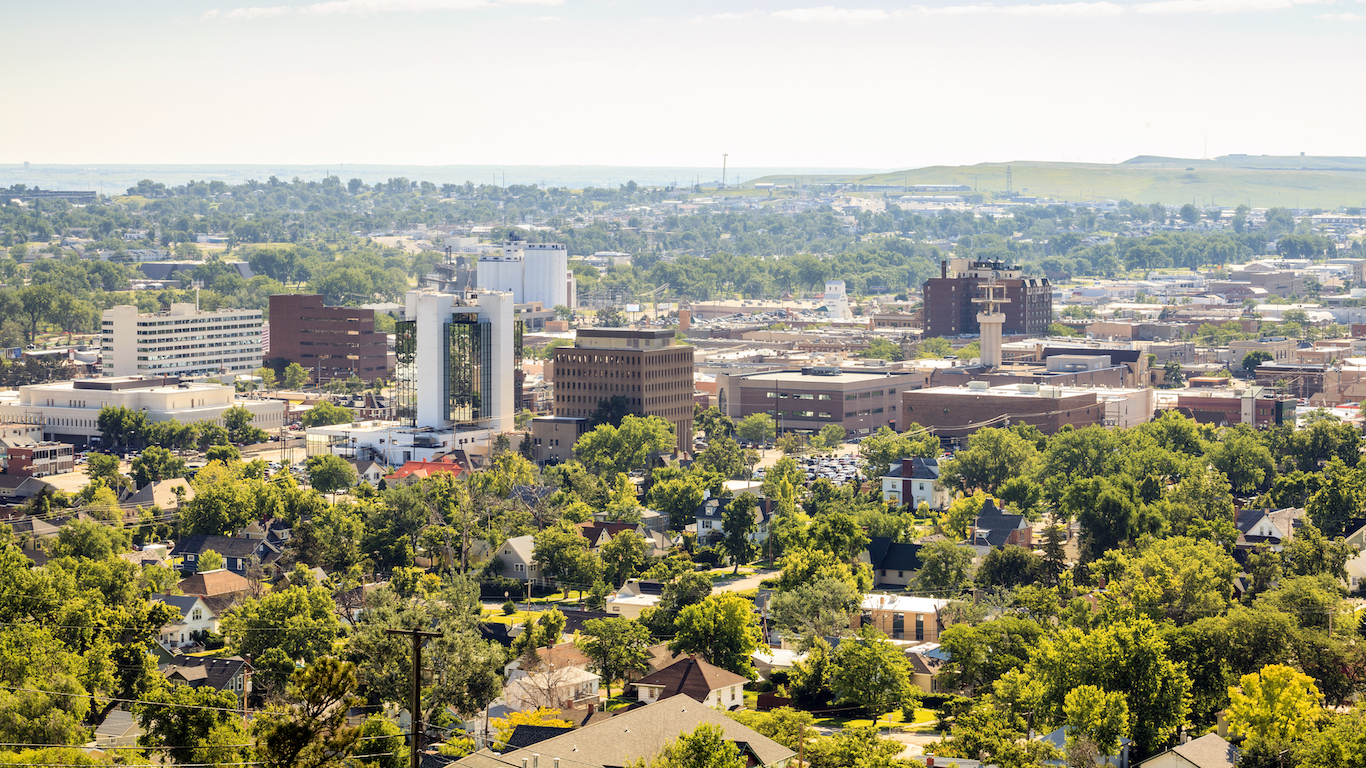
4. South Dakota
> Volunteer rate: 35.3%
> Adults with at least a high school diploma: 91.1% (13th highest)
> Total value of volunteer work in 2015: $542.7M (5th lowest)
> Unemployment rate: 2.8% (tied – 3rd lowest)
There are more Midwestern states with high volunteer participation than any other region in the country. In South Dakota, 35.3% of residents 16 and older volunteer on a yearly basis, far higher than the 24.9% of Americans nationwide. As with most states, churches and religious organizations account for the largest share of volunteers, followed by educational or youth services.
Widespread volunteerism in South Dakota is likely bolstered by shorter commuting times. People with longer commutes can have less free time to volunteer, and in South Dakota, the average commute is only 17 minutes, the second shortest of any state in the country.
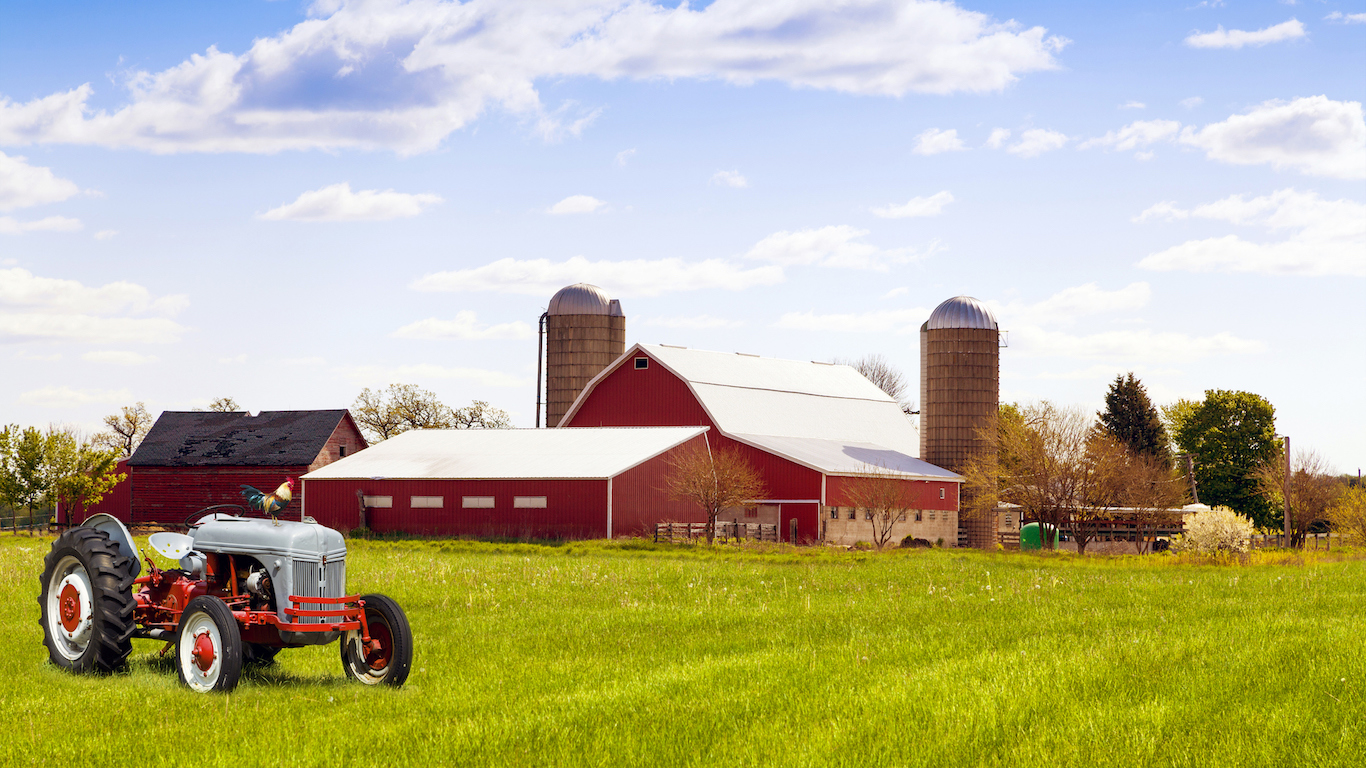
3. Wisconsin
> Volunteer rate: 35.3%
> Adults with at least a high school diploma: 91.4% (11th highest)
> Total value of volunteer work in 2015: $4.40B (15th highest)
> Unemployment rate: 4.0% (tied – 17th lowest)
There are only six states in the country where over a third of the adult population volunteers each year, and Wisconsin is one of them. The state is one of several in the Midwest with especially high volunteer participation rates. Not only are Wisconsin residents more likely to volunteer than most Americans, but they also volunteer more of their time. Residents in Wisconsin volunteered the equivalent of 42.9 hours in 2015, more per capita than every state except Utah.
The majority of volunteers in Wisconsin are mobilized either through their church or religious group, or an educational or youth organization.

2. Minnesota
> Volunteer rate: 35.4%
> Adults with at least a high school diploma: 92.8% (3rd highest)
> Total value of volunteer work in 2015: $3.57B (20th highest)
> Unemployment rate: 3.9% (14th lowest)
About 35.4% of adults in Minnesota volunteer each year, dedicating a total of 141.8 million hours in 2015 alone. Nationwide, volunteerism rates are higher among adults with jobs and those with high school diplomas. In Minnesota, low unemployment and relatively high education levels may partially account for the relatively large share of the population that volunteers. Some 92.8% of Minnesota adults have at least a high school diploma, well above the 87.1% share nationwide. Additionally, only 3.9% of the state’s labor force is unemployed, below the 4.7% national rate.
Community pride is often a motivation for volunteer work. Homeowners are often invested in their community and have an interest in its long-term prosperity, and Minnesota’s 70.9% homeownership rate is the third highest in the country.
[in-text-ad-2]
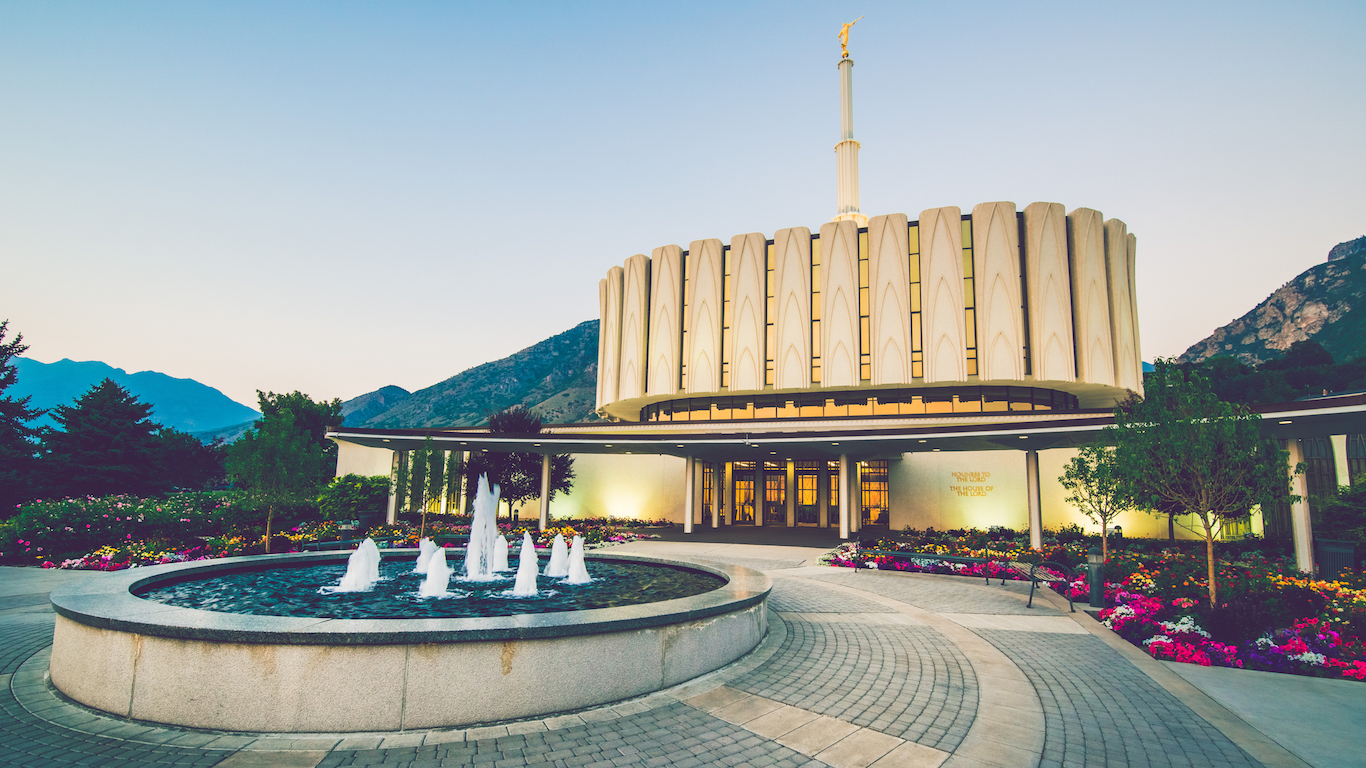
1. Utah
> Volunteer rate: 43.2%
> Adults with at least a high school diploma: 91.5% (10th highest)
> Total value of volunteer work in 2015: $3.89B (18th highest)
> Unemployment rate: 3.1% (tied – 8th lowest)
No state has a higher rate of volunteerism than Utah. Each year, about 43.2% of the state’s adult population volunteers, far higher than the national 24.9% rate. Utah is home to nearly a third of the total U.S. Mormon population, and religion plays a major role in volunteerism across the state. Some 65.4% of volunteers in the state are mobilized through their religious institution, by far the largest share of any state.
Not only are Utah residents the most likely in the country to volunteer their time, they also volunteer far more of it. Volunteers in the state committed the equivalent of nearly 76 hours of their time for every resident 16 and older in 2015 alone, by far the most time of any state and well above the comparable national figure of 31 hours.
Travel Cards Are Getting Too Good To Ignore (sponsored)
Credit card companies are pulling out all the stops, with the issuers are offering insane travel rewards and perks.
We’re talking huge sign-up bonuses, points on every purchase, and benefits like lounge access, travel credits, and free hotel nights. For travelers, these rewards can add up to thousands of dollars in flights, upgrades, and luxury experiences every year.
It’s like getting paid to travel — and it’s available to qualified borrowers who know where to look.
We’ve rounded up some of the best travel credit cards on the market. Click here to see the list. Don’t miss these offers — they won’t be this good forever.
Thank you for reading! Have some feedback for us?
Contact the 24/7 Wall St. editorial team.
 24/7 Wall St.
24/7 Wall St.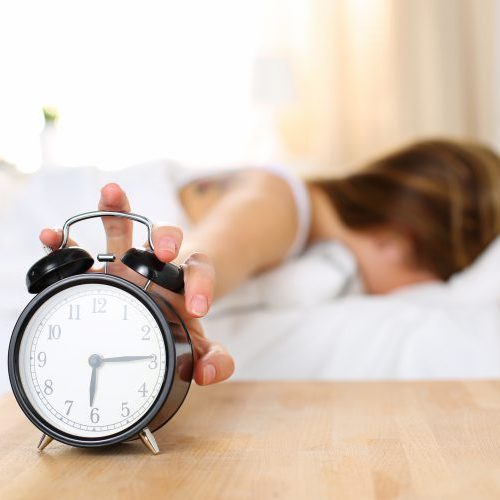 24/7 Wall St.
24/7 Wall St.



